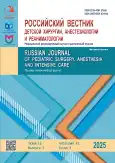Amyand’s hernia in a two-month-old infant with extremely low birth weight: a case report
- Authors: Perepelkin A.I.1,2, Sinitsyn A.G.1,2, Kopan G.A.1,2, Shomah A.I.1,2
-
Affiliations:
- Volgograd State Medical University
- Clinical Emergency Hospital No. 7, Volgograd
- Issue: Vol 15, No 3 (2025)
- Pages: 423-430
- Section: Case reports
- URL: https://journal-vniispk.ru/2219-4061/article/view/343622
- DOI: https://doi.org/10.17816/psaic1940
- EDN: https://elibrary.ru/BAPIML
- ID: 343622
Cite item
Full Text
Abstract
Amyand hernia is a congenital condition characterized by the presence of the appendix within the inguinal hernia sac, and it is a rare intraoperative finding in pediatric practice. This article presents the clinical case of a two-month-old infant admitted to the pediatric anesthesiology and intensive care unit of Volgograd City Emergency Clinical Hospital No. 7. The patient was one of twins, born with extreme prematurity (26 weeks of gestation) and an extremely low birth weight (900 g). The deterioration of the patient’s condition was associated with marked irritability, swelling, induration, and hyperemia of the scrotum extending to the pubic region and right inguinal area, laboratory-confirmed leukopenia with a left shift, and an increase in C-reactive protein to 149.2 mg/L. At admission to the surgical ward, the patient’s condition was severe. Body temperature was 37.8 °C. Consciousness was preserved, and the patient responded to examination with painful crying. Neurologically, diffuse hypotonia and decreased reflex activity were noted, along with weak oral automatism reflexes and rapidly fading spinal reflexes. Locally, edema and hyperemia were observed in the right inguinoscrotal region, with hyperemia extending from the scrotum to the right inguinal canal and pubic area. Palpation revealed a firm, elastic mass measuring 4.0×1.5–2.0 cm in the inguinoscrotal region distal to the internal inguinal ring, whereas the right testis was not identified separately. On the left side, an inguinal-scrotal hernia up to 4.0×3.0 cm was freely reducible into the abdominal cavity, without hyperemia. Emergency right-sided herniolaparotomy was performed. The hernia sac contained the appendix with a bulbous enlarged tip measuring 0.7×0.5 cm, palpably fluctuant. Appendectomy was performed using ligature technique. Histological examination of the resected appendix revealed signs of acute phlegmonous inflammation. The postoperative course was uneventful. On postoperative day 4, the infant was transferred to the Volgograd Regional Children’s Hospital with recommendations for elective surgery for the contralateral inguinal hernia. This case highlights that timely recognition, early surgical intervention, and an individualized approach to treatment significantly improve prognosis. Heightened vigilance, particularly in the context of prematurity and multiple organ immaturity, remains a key element for the successful diagnosis and treatment of this rare condition. In the analyzed case, the surgical intervention enabled timely diagnosis and prevented complications associated with the risk of appendix perforation, the development of peritonitis, and progression of inflammatory processes in the soft tissues of the inguinoscrotal region.
Full Text
##article.viewOnOriginalSite##About the authors
Andrey I. Perepelkin
Volgograd State Medical University; Clinical Emergency Hospital No. 7, Volgograd
Author for correspondence.
Email: similipolai@mail.ru
ORCID iD: 0000-0001-5964-3033
SPIN-code: 5545-8353
MD, Dr. Sci. (Medicine), Professor
Russian Federation, Volgograd; VolgogradAleksey G. Sinitsyn
Volgograd State Medical University; Clinical Emergency Hospital No. 7, Volgograd
Email: all-sur04@mail.ru
ORCID iD: 0000-0002-8308-8364
SPIN-code: 3223-7231
MD, Cand. Sci. (Medicine)
Russian Federation, Volgograd; VolgogradGleb A. Kopan
Volgograd State Medical University; Clinical Emergency Hospital No. 7, Volgograd
Email: gleb.kopan@yandex.ru
ORCID iD: 0000-0002-6627-1028
SPIN-code: 1465-6360
MD, Cand. Sci. (Medicine), Assistant Professor
Russian Federation, Volgograd; VolgogradAhmad I. Shomah
Volgograd State Medical University; Clinical Emergency Hospital No. 7, Volgograd
Email: ahmadshomah@yahoo.com
ORCID iD: 0009-0007-5553-4826
Russian Federation, Volgograd; Volgograd
References
- Suliman A, Elfaki H, Hussein S. Amyand’s hernia in a 2-month-old infant: The first case report from Sudan. Int J Surg Case Rep. 2024;122:110114. doi: 10.1016/j.ijscr.2024.110114
- Ocaña PA, Gonzalez L, Llerena EL, et al. Amyand hernia with acute appendicitis in a patient with ambiguous genitalia: a case report. J Pediatr Surg Case Rep. 2025;117:102992. doi: 10.1016/j.epsc.2025.102992
- Losanoff JE, Basson MD. Amyand hernia: a classification to improve management. Hernia. 2008;12(3):325–326. doi: 10.1007/s10029-008-0331-y
- Kotaluoto S, Ukkonen M, Pauniaho S-L, et al. Mortality related to appendectomy; a population based analysis over two decades in Finland. World J Surg. 2017;41(1):64–69. doi: 10.1007/s00268-016-3688-6
- Sarah-May ML, Anne-Fleur MH, Derikx JPM, et al. Appendicitis and its associated mortality and morbidity in infants up to 3 months of age: A systematic review. Health Sci Rep. 2023;6(9):e1435. doi: 10.1002/hsr2.1435
- Kumar R, Mahajan JK, Rao KLN. Perforated appendix in hernial sac mimicking torsion of undescended testis in a neonate. J Pediatr Surg. 2008;43(4):e9–e10. doi: 10.1016/j.jpedsurg.2007.11.031
- Logan MT, Nottingham JM. Amyand’s hernia: a case report of an incarcerated and perforated appendix within an inguinal hernia and review of the literature. Am Surg. 2001;67(7):628–629. doi: 10.1177/000313480106700705
Supplementary files







